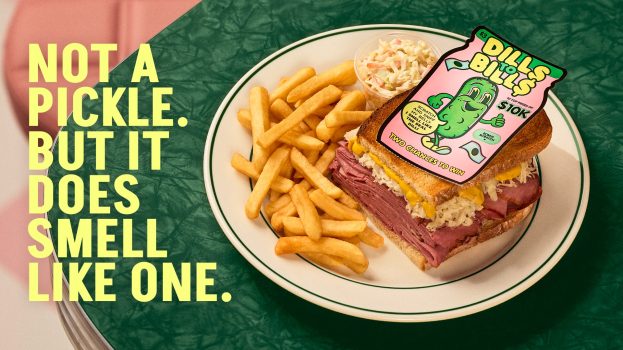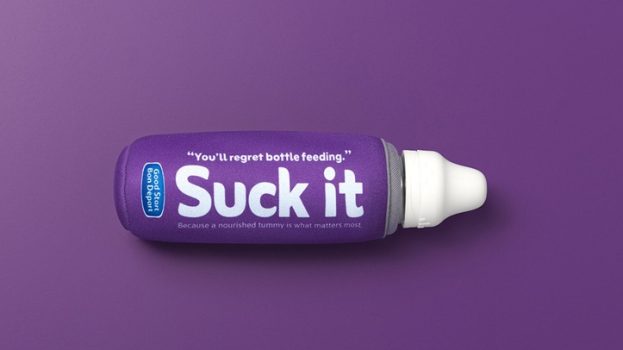Inside a corner of Campbell’s vast 500,000-square-foot plant, gigantic carrots, some triple the size of what you would see in the grocery store, are making their way through a machine that will chop them into bite-size pieces. They have already been cleaned and peeled, and later they will be dropped into cans, along with broth and other ingredients. Once sealed and protected, it will take a day to transport these cans of soup to the warehouse, and a month or two for consumers to find them at the store.
This is how Campbell’s soup gets to ‘m’m, m’m good’ and perhaps the most interesting part is that the vegetables aren’t freeze-dried, but actually come straight from the farm – most are grown in Southern Ontario. In fact, every year, a total of 50 million pounds of fresh vegetables are processed by the Campbell Soup Company. That’s something that the Toronto-based CPG firm is becoming increasingly vocal about, and it plans to aggressively ramp up its consumer communications about this benefit and others going forward.
The move is part of a transformation that has been occurring for about half a decade, explains VP marketing Mark Childs. ‘Certainly for this year, and for sure going into next, there’s no question that Campbell’s is back, with renewed commitment and an optimistic view of what’s ahead.’ Indeed, since Childs joined the company in fall 2004, the goal has been to put the customer back at the front of the process, specifically when it comes to creativity and ideas. Childs refers to this shift as ‘consumer ideas first.’
So far, the philosophy has led to various product reconfigurations, such as soup containing one whole tomato in each can, V8 with less sodium, plus a Health Check designation from the Heart & Stroke Foundation of Canada, and Soup at Hand, the portable, drinkable product which launched last August, to name but a few.
Brent Scowen, VP of commercial and customer development, says Soup at Hand has enabled Campbell’s to penetrate new channels, like gas and convenience chains. Currently, the product is in 4,000 new points of distribution, and it has even been incorporated as part of a soup and sandwich combo deal at both 7-Eleven stores and Petro Can gas bars. ‘The [retail] customers wanted legitimacy around their lunch offerings, because they are competing with ‘fresh’ retailers, like Subway. Yet they deal directly with suppliers, so there’s no brand credibility.’ Enter Campbell’s, which through the arrangement – secured by account managers who worked with both consumer and customer marketing teams – was able to get ad exposure via POS, shelf talkers, and stickers on the sandwiches, as well as pump topper posters at Petro-Can. Buoyed by the success of Soup at Hand, Campbell’s will launch Chunky single-serve microwaveable bowls in the fall.
At traditional retail, meanwhile, Campbell’s is also breaking the rules, with the introduction of the IQ Shelf Maximizer, which is currently being tested in Western Canada. Originally conceived in the States, the system allows consumers to easily find their soup, as the product is segmented and colour-coded, with categories such as ‘broth’ and ‘wellness +.’ When the consumer grabs a can off the shelf, another slides into its place. The gravity-operated Maximizer also accommodates retailers’ private-label brands, which made it an easy sell.
‘[Grocers] were struggling with centre of the store growth – they weren’t seeing innovation, they wanted help,’ explains Scowen, who adds that the company has so far seen sales increases of 3.5% to 7% at the 350 stores equipped with the new shelving unit. While the next rollout was originally supposed to be exclusively reserved for Ontario, expansion has been accelerated right through to Newfoundland, and Scowen plans to have 1,000 systems installed within 12 months.
Meanwhile, back at HQ, Campbell’s has been rallying its staff around its vision: ‘extraordinary, authentic nourishment for all.’
The Canadian firm adopted this philosophy as a version of Campbell’s global vision ‘nourishing people’s lives, everywhere, every day.’
It all started when the executive team developed six values – collaboration, community, creativity, competitive, courage and can do – to help staffers live and breathe the new company mantra.
Since then, in the last year and a half, Campbell’s has done its absolute best to engage employees, by advertising those values on company walls, by introducing a Wellness Within initiative, which enlists dieticians to help develop and deliver nutritional awareness programs inside the organization, and by creating new brainstorming rooms that have been decorated and named by staff, among other things.
The firm is also in the process of turning its former smoking lounge into a health and wellness corner, and has enlisted a cross-functional team to design a mural representing Campbell’s journey thus far. Meanwhile, the vision statement was recently printed on a sign outside the building, for all to see on their way into work. ‘That was a big step, because we felt that we’d built up enough evidence internally, that we could say it with confidence,’ says president Phil Donne, who has been at the helm of Campbell’s since the summer of 2002. ‘So now in the next nine to 12 months, we’ll be trying to communicate that more with consumers.’
Strategy sat down with Donne and members of his executive team to get the details about Campbell’s internal and external campaigns, plus what it plans to serve up in the future.
Panel:
Phil Donne, president
Mark Childs, VP marketing
Jacki Nelson, director of communications and government relations
Greg Smith, VP human resources
What consumer insights and trends are driving your business for the future?
Donne: Wellness is a big one and we believe we are reflecting [that] in our portfolio. The on-the-go and convenience is critical, and we think we’re really starting to get into that area, with the launch of Soup-at-Hand. The other would be meal solutions, and time-pressed consumers looking for ways that they can bring a meal to the table, with maybe 15 minutes prep. So how can we help facilitate that? Another would be consumers buying more premium offers. If you look at Gardennay, it’s a wellness product, and it’s restaurant quality soup. So we’re getting at two of those at once.
Childs: The last 12 to 18 months consumers have started to notice us being more assertive in the marketplace, talking about those four things. From a meals solution point of view, we’ve reinvented cooking again – it’s coming back to some of the basics of cooking, for which our products provide quite simple solutions. In terms of wellness, we’re trying to make the healthy choice the easier choice, and we’re trying to simplify it rather than make it more complex. Some might argue that is a countertrend.
What are some of the research methods you used?
Childs: We’re actually blending pure disciplines of research, whether it be food development work or consumer insights, together, and really looking at the consumer’s perception of the product in its entirety – the packaging, the food, the messaging. When we test food, we’re also looking at consumer insights from that research and vice versa. We did a big usage and attitude study last year, and we went back into the archives to research from years gone by and looked at it with fresh eyes, right through to interviews in home.
What did you learn?
Childs: In many ways it reinforced the four things we talked about. Canadian consumers are more health conscious and are making more balanced choices. They are willing to make a little bit of a taste trade-off.
Also, the revelation of what’s inside the can, the box, or the cup is actually newsworthy and throughout our various research and different stages of development and advertising our product, [we found that] consumers appreciate [the notion of fresh vegetables].
Donne: People I’ve accompanied on the plant tour have said: ‘I thought you used freeze-dried or reconstituted vegetables, but actually you have a machine over there that decores cabbage.’ It brings a value that sometimes we don’t infuse into packaged products. Going forward, we’re aware there’s a positive tension between listening to consumers and leading consumers. And I think when it comes to listening to consumers, we have a great sense of experimentation on the team, and a real drive to find insights before anyone else does.
Some of the best insights I’ve ever received were while walking the stores with some of the senior people on our accounts. They say
things that are just true for them, but that are pretty shocking.
Can you give an example?
Donne: I was with one of them a couple of years ago and I said: ‘you obviously have a healthy lifestyle, when we stand in front of the soup aisle, what comes to mind?’ He looked at me and said: ‘It’s a category that’s been stuck in the ’60s.’ Wow.
In one context he was right, but in another he was wrong, because he wasn’t able to perceive the things we were doing like [the launch of] Gardennay.
So it’s making how you’ve changed and upgraded the category much more of an interactive discussion. You reinforce it on a pack by showing the vegetables, you add to your ads that it’s a serving of vegetables.
How are you getting the fresh message out?
Childs: We have a TV commercial [by BBDO Toronto] that’s been running for the last year [showing the vegetables for Campbell soup coming from a farm.] It’s making that overt direct connection that what’s inside the can is what comes out of the field.
Then, we’ve been running some print messaging specifically to moms that declares: ‘Mom, I hate vegetables,’ which really builds into that insight that kids think that they don’t like vegetables. The cool thing about this creative is it actually asks you to peel off the H, to say: ‘Mom, I ate vegetables.’ And similarly, we’ve been doing print [depicting carrots wrapped in a Campbell’s label], which really just reframes what’s in a can of soup, in a very simple, uncomplicated, authentic way.
Collaboration is one of your internal values. Has marketing achieved a better dialogue with other departments internally?
Donne: As a broad theme we talk about one commercial team, meaning we’re integrated across all the different disciplines across the organization. And marketing, more so than in any other time in my career, is so integrated with manufacturing, human resources, finance. It’s understanding the plant floor for instance. At the end of the day, we have to work together to bring the best possible products to consumers in a way that goes beyond their expectations.
Childs: There’s a great example of the marketing team working with the purchasing team. They had a field trip together to the farm where the product has been made for decades.
So when we talk about the value of collaboration, that’s really bringing it to life. It ultimately has led to even a greater insight. The stories told by the farmer, I don’t think you could measure that.
The multi-teams also go beyond our four walls. Just recently we had the agency creative team briefing in the plant. And with Gardennay and the upcoming work we’re developing, we held the briefing at [Toronto’s] St. Lawrence Market.
Smith: [At one point] we discovered that 50% of our top talent, weren’t serving our products. Many of us didn’t even know [how they were made]. So it’s getting reconnected to the truth of our products and that sets a foundation for a common energy. We believe in the products we’re bringing forward. That drives a lot of that one-team approach.
Donne: By getting to know each member of the team and his/her role and contributions, through the factory, through purchasing, I think it’s created a visceral respect for the product. So when we sit down together and think about how we’re going to treat this new product, we have an appreciation for where it came from, and how much care people put into it.
There are a couple of words that I think have been guiding us as well. Are we ‘legitimate’ as we move forward on health and nutrition? Well, we think we are, because of the company’s history and origins to provide fresh foods across the country. What we’ve been trying to do over the last few years is be ‘credible.’ As we’re making decisions on new product, we start to build up that evidence, so that one day we will be able to embrace that vision publicly.
On the topic of health credibility, have you been gaining support from professional groups?
Nelson: We’re working very closely with Dieticians of Canada. They are having their national conference, and we have six of our registered dieticians attending, and we’re showcasing products. We’re actually doing qualitative research – asking them about our products, about trends and some of the groups we’re thinking about partnering with on our health and wellness relationships. There are about 2,500 dieticians across Canada who attend this conference and the takeaway materials are sponsored by Campbell’s. It’s outreach to that community in a way that’s information sharing, but again creating credibility in our product and our focus on health
and wellness.
What other types of below-the-line activities are you engaging in?
Childs: Another big part of it is reinventing soup for today, in a cup or in a different format. A lot of our focus is actually having people try the product and hopefully feel like there’s something authentic, new, and interesting. We do in-store sampling, event sampling. We have a couple of things that we’re planning for Labour Day that I think will be disruptive.
Nelson: We also run the Labels for Education program, which is a program at 8,000 schools across Canada right now, and we’re helping to inspire and engage kids in healthy eating. It’s teaching them about growing a vegetable garden, how to pack a healthy lunch, and healthy living.
Can you talk about some of the work you’ve done in-store?
Donne: The IQ Maximizer is going to be a big part of our investment this year. It will help you rediscover the category and then hopefully move over to Gardennay or to broth.
Childs: There’s other packaging like the shrink-wrap multipacks that [enable] advertising in store, [because you can print images directly on them] and next year we’ll be inserting recipe books and other things inside the package. It’s a shift and I think we’re looking at consumers also as people who cross the threshold of grocery stores. How do we continue that brand messaging in a consistent way that actually doesn’t differentiate TV, to radio, to print, to a coupon on the shelf, or a decal on the floor? How do we make that work harder for us?
Have you increased spend on trade and below the line?
Childs: We’ve increased our spend on consumer communications, whether it be mass or below the line. With advertising coverage across the year, two years ago we were probably at about 80 weeks of advertising. Coming into the next year, it’s 146. Today you’re seeing Campbell’s in a variety of media from August through to June or July, whereas in the past, it very much focused on what we’ve traditionally called soup season, from November through February. Soup at Hand is the perfect product right now. It may be 100 degrees outside, but inside office buildings it’s pretty cold. Our new messaging [which breaks in fall] will be clearly about this product not being around cold temperatures exclusively.
How much of your advertising is adapted and when do you decide to go with local versus global work?
Childs: As we’re making this transition to being more visible with Canadians, it’s a blend. We steal with pride. I actually tell the team ‘build with pride.’ Today there is Canadian-specific work on Gardennay, there is Canadian-specific work on vegetable, and we’re stealing with pride on the NFL Chunky advertising. It works for Canadians. It’s investing our money where it has the greatest impact.
Our role within the broader North American division which is Canada, the U.S., Mexico and Latin America, is ‘innovation incubator.’ That doesn’t mean new products only. It means innovation in process, commercial ideas and advertising. We’ve built relevance for Canadians in these products.
Why have you been deemed ‘innovation incubator?’
Childs: I think we have a track record in success. Gardennay was pioneered in France. We built on it, and we built a very successful business, demonstrating our credibility to the North American market, as well as globally. Its repeat business is 46% to 47%, which far exceeds the industry standard. It is now in a different brand form in the U.S. market. Chunky Chili was also a Canadian launch that’s been [picked up] in the U.S.
Nelson: Some of our relationship-building with culinary professionals and health professionals, and also partnerships with the Heart & Stroke Foundation in Canada [have traveled]. In the U.S., they linked with Heart & Stroke as well. It’s about partnerships, but also looking for ways to work together, through research or using messaging like the Health Check symbol you see on some of our products.
What has been consumer response to the changes at Campbell’s so far?
Childs: On a fiscal year to date, according to Nielsen numbers, the category is up four, we’re up six, and that’s pretty much healthy growth, including a balance of trade promoted and base consumption. Campbell’s growth is exceeding and leading the broader category.























